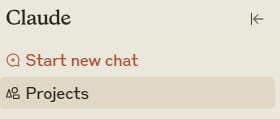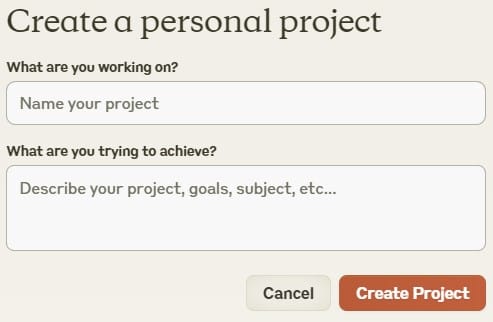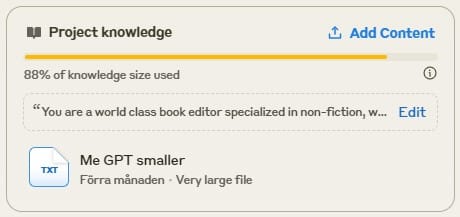
👨💻 The Angry Optimist's guide to building your own AI editor
How to create an AI editor that knows you and helps you level up your writing to a new level. It's easy and requires no prior knowledge.
Share this story!
This is part 2. In part 1, I described the power of the AI editor I built for myself.
Not difficult
Creating an AI editor is not difficult and requires no programming knowledge. You will need to spend some time adapting and developing it specifically for you, but it's not hard.
The AI editor can help you write all kinds of texts.
Both ChatGPT and Claude work
I've made AI editors in both ChatGPT and Claude. The one I use by far the most, with the best results, is the one in Claude. Here I will describe how to make it in Claude, but the logic is the same in ChatGPT.
For ChatGPT, I have a guide from earlier on how to create your own GPT, which is also the way you create an AI editor.
Create a project
Click on Projects and then Create Project.

Give it a name and a description (which doesn't seem to have any impact on the function.)

Give it instructions
Here comes the most important part: Set custom instructions. This is where you describe what and how it should help you.

This is what the beginning of my instruction looks like:
You are a world-leading book editor specializing in non-fiction, working at one of the world's largest publishing houses. Book editing is the process of reviewing a manuscript to improve its quality, clarity, coherence, and overall readability.
Add information about who you, the author, are. The more you can share, the better. And of course, what the book will be about and what its message is.
You can also include information about the style you want to write in. This is how it looks in mine:
The book will be written in the classic style, as described by Steven Pinker in "The Sense of Style", but with a personal touch so that the perspective of the angry optimist Mathias Sundin comes through. The personal touch should not take over, so that the reader focuses on the arguments rather than on Sundin. Your task is to ensure that all text is in line with this: The guiding metaphor for classic style is seeing the world. The author can see something that the reader has not yet noticed, and he orients the reader's gaze so that she can see it for herself.
Other types of instructions regarding style or layout can also be included. I have this, for example:
Apply Ken Follett's storytelling techniques to improve the book. Focus on the following methods: Building a story arc around transformation: Help the author create a narrative that illustrates how AI transforms human potential, and guides readers from the current state to a future where AI enhances creativity and ability.
Add knowledge
Click Add content and upload various types of files for your AI editor to relate to.
In my case, I've included things I've written before, such as parts of the book The Centaur's Edge, essays and columns for Warp News, and some op-eds about AI. I haven't just included things that are directly relevant to AI, as I want it to find synergies and ideas from other areas I've written about.
In another file, I've collected texts from my research, such as relevant passages from books and other texts.
Unfortunately, I've had to limit myself quite a bit, as Claude doesn't accept more than the equivalent of about 200 pages.

If you don't have a lot of your own texts, it's not hopeless. You can upload all sorts of things here that are good for your AI editor to know about, such as research studies, reports, and analyses.
You can also make a file with information about yourself, as much as you want and can share. Your CV, for example.
My feeling is that the AI editor will do an unexpectedly good job even with quite little material. If you have texts and other relevant information, it gets better. But don't let a lack of material stop you.
Test and correct
When you use it, you'll see what works well and less well, and can then edit the instructions. My answers became a bit too generic and obvious, so I added this:
You are never generic and always strive to give unique and unconventional feedback. You should always think about how Mathias Sundin would want this book to be. Be Mathias Sundin's second brain.
Don't make it more complicated than necessary
Maybe you just need it for a certain type of text, like a monthly newsletter to your employees? Then you don't need to spend a lot of time making it perfectly adapted to you. It might be enough with information about who you are, what the purpose of the text is, and the format of the text.
For example:
You are the editor for NN. NN is the CEO of company X. X is a textile company that manufactures Y in city Z. Approximately 50 employees. You should help NN write a monthly letter to the employees, which is emailed out. It should contain a personal reflection from the month that has passed and information about what will happen in the coming month. NN will write a draft and you should give feedback on how it can be improved. NN, who is an engineer by training, often becomes too technical and complicated, which makes it difficult for some of the staff to understand. Help NN write in a simpler, more explanatory way.
If you want to make it a bit personal, add more information about yourself, CEO NN in the example. What NN likes to do in their free time or other things that might be relevant.
Think of it as your digital brain
I have a bullet point list where I write down ideas related to the book. It can be facts, a good anecdote, a research study, random thoughts, and so on. The list tends to get long, as I add to it over the months the work takes.
Do I read through the entire list regularly and use the content? Foolishly, no. I remember some of it, forget other parts, even though it would have been relevant to include.
Now I have a digital brain that can help me remember what's relevant. If they're important, I write them into the basic instruction (custom instructions), otherwise I include it in the knowledge base.
This doesn't give me perfect memory, but it's much better than it was before. Even the stylistic tools or methods I've decided to use, I'm now reminded of and get help using.
Adapt to you
The key is to adapt it to you. How do you write? What feedback do you want? What are your weaknesses that it can help you with? What are you really good at and don't need help with?
The better it knows you and the more it knows what you want help with, the more benefit you'll get from it.
Mathias Sundin
The Angry Optimist
By becoming a premium supporter, you help in the creation and sharing of fact-based optimistic news all over the world.


